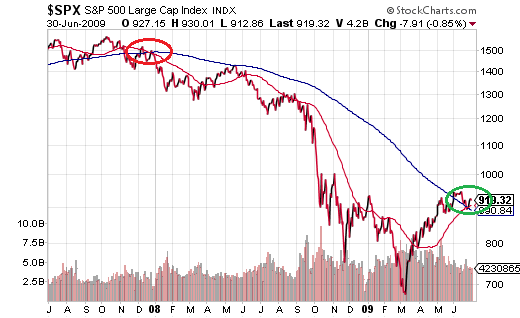It is unsettling to deal with the probability that we are closer to a bearish decline in stocks than a bullish reboot. Investment account values will wane. Household net worth will diminish. And when stock prices near their lowest ebb, the typical investor will decide that buying is impractical.
However, if one prepares for inevitable depreciation in overvalued asset prices, buying low becomes less intimidating. For example, in spite of the exceptionally poor rap that trend-following techniques receive from the mainstream financial media, a decision to “stand down” when the 50-day crossed below the 200-day in the previous stock bear provided a remarkably desirable return OF capital. A subsequent decision to embrace risk when the 50-day crossed above the 200-day provided a remarkably desirable entry point for a return ON capital. Selling the S&P 500 near 1500 (a.k.a. “selling high”) and purchasing it again near 900 (a.k.a. “buying low”) helped one successfully transition from capital preservation to capital appreciation.

At the current moment, far too many folks are being led astray by talking points they hear on CNBC and Bloomberg. For instance, popular shows regularly trot out analysts who insist that that market is “grinding higher.” First of all, which market is grinding higher? The Dow Industrials, Dow Transports, S&P 500, S&P 400, Russell 2000 and New York Stock Exchange (NYSE) Composite are all lower than they were one year ago. (Note: Ironically enough, the Fed’s last asset purchase actually occurred on 12/18/2014, making 12/17/2015 the end of a full trading year.)
It follows that the only significant U.S. index that has made genuine progress since the end of the Federal Reserve’s quantitative easing (QE3) is the NASDAQ. Even there, progress is less impressive when one weights the components of the NASDAQ equally, rather than rely on the super-sized weightings of Facebook (FB), Amazon (AMZN), Netflix (NFLX) and Google (GOOG). This is evident in the deterioration of the First Trust Equal Weight NASDAQ 100 (QQEW): Powershares NASDAQ 100 ETF (QQQ) price ratio.









Leave A Comment